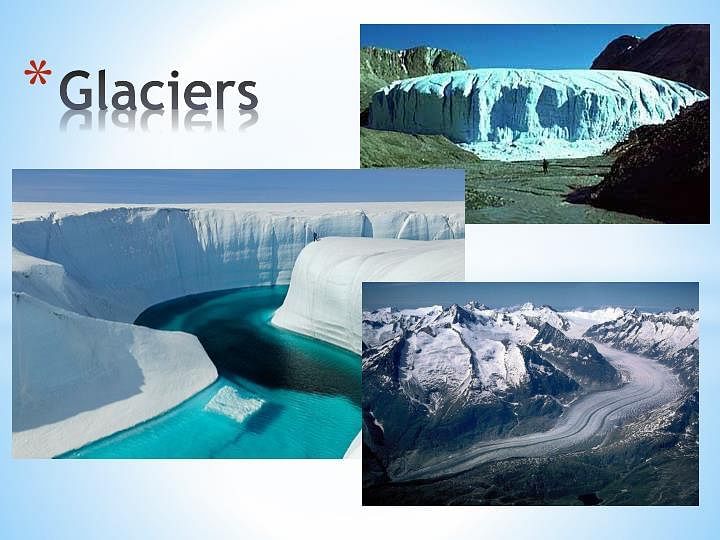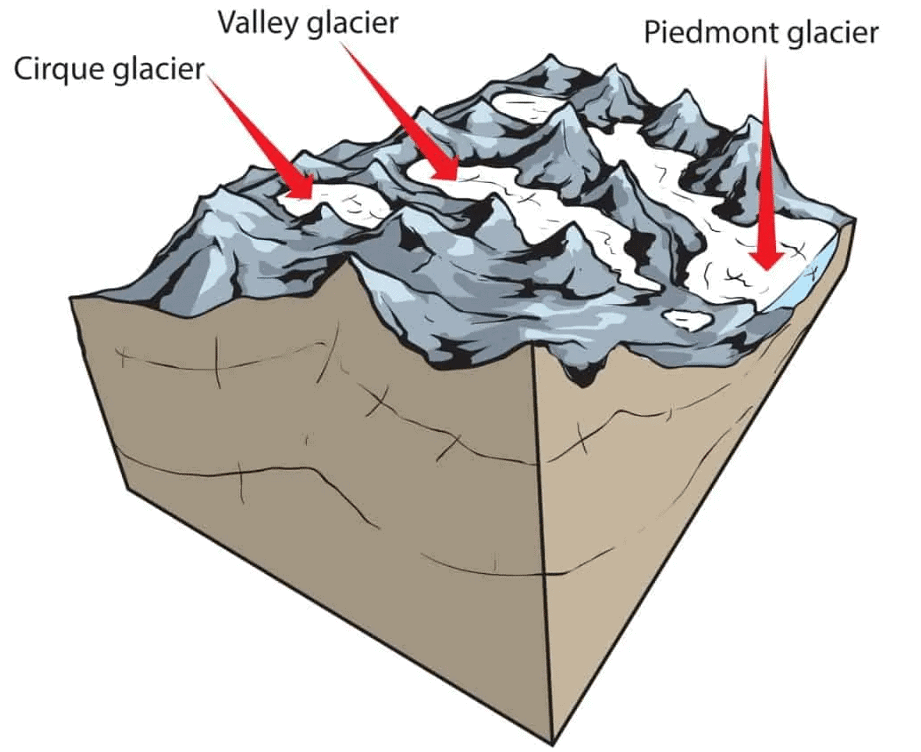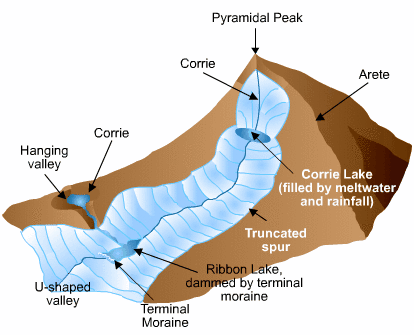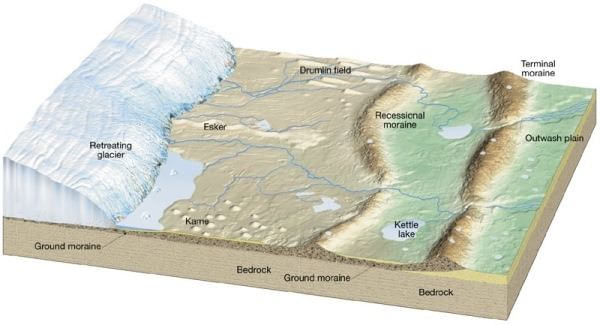UPSC Exam > UPSC Notes > Geography for UPSC CSE > GC Leong Summary: Landforms of Glaciation
GC Leong Summary: Landforms of Glaciation | Geography for UPSC CSE PDF Download
The Ice-Age and the types of ice masses

- Today, only 2 major ice caps are present in this world - Antarctica & Greenland, along with many highlands above the snowline surviving in the world.
- The peaks of the loftiest mountains projecting above the ice surface are known as Nunataks.
- Ice from ice cap creeps out in all directions to escape as glaciers.
- When the ice sheets reaches down to the sea they float as ice shelves in polar waters.
- When ice sheets breaks into individual blocks, these are called icebergs.
- While afloat in the sea, only l/9th of the iceberg’s mass is visible above the surface.
- They diminish in size when reaching warm waters & eventually melted, dropping the rock debris that was frozen inside them on the sea bed.
- Permanent snowfield is sustained by heavy snowfall in winters & ineffective snow melting & evaporation in summers as part of snow that melt during the day is refrozen during the night.
- This refreezing process repeats until it forms a hard, granular substance known as neve or firn.
- Owing to the gravitational forces, neve of the upland snowfield is drawn towards the valley below, which marks the beginning of the flow of glacier (river of ice).
Glaciers

- Glaciers normally assume the shape of a tongue, broadest at the source & becoming narrower downhill.
- Though glacier is not liquid, but it moves gradually under the continual pressure from the snow accumulated above.
- Rate of movement is greatest in the middle where there is little Obstruction.
- The sides & bottom are held back by the frictions due to valley sides & valley floors.
- If a row of stakes is planted across a glacier in a straight line, they will eventually take a curved shape down the valley, showing that glacier moves faster at the centre than at sides.
Types of Glaciers


Landforms of Highland Glaciation

- Glaciation generally gives rise to erosional features in the highlands & depositional features on lowlands.
- It erodes its valley by two processes viz. plucking & abrasion.
- Plucking → Glacier freezes the joints & beds of underlying rocks, tears out individual blocks & drags them away.
- Abrasion → Glacier scratches, scrapes, polishes & scours the valley floor with the debris frozen into it.
Characteristics features of Glaciated Highland
 1. Corne, Cirque or cwm
1. Corne, Cirque or cwm
- The downslope movement of a glacier from its snow covered valley head & the intensive shattering of the upland slopes, tend to produce a depression where neve or firn accumulate.
- Plucking & abrasion further deepen the depression into a steep horse shoe shaped basin called Cirque (in French), cwm (in wales) & Corrie (in Scotland).
- There is a rocky ridge at the exit of the corrie & when the ice eventually melts, water collect behind this barrier known as Corrie Lake or tarn.
2. Aretes and Pyramidal Peaks
- When two corries cut back on opposite sides of the mountain, knife edged ridges are formed called aretes.
- When three or more cirques cut back together, recession will form an angular horn or pyramidal peak.
3. Bergschrund
- At the head of a glacier, where it begins to leave the snowfield of a corrie, a deep vertical crack opens up called a Bergschrund or Rimaye.
- This happens in summer when although the ice continues to move out of the corrie, there is no new snow to replace it.
- In some cases not one but several such cracks occur which present a major obstacle to climbers.
- Further down, where the glacier negotiates a bend or a precipitous slope, more crevasses or cracks are formed.
4. U shaped glacial Troughs & Ribbon lakes
- Glaciers on their downward journey are fed by several comes scratches & grind the bedrock with straightening out any portruding spurs.
- The interlocking spurs are thus blunted to form truncated spurs with floor of the valley deepened.
- Hence, the valley which has been glaciated takes the characteristic U shape, with a wide flat floor & very steep sides.
- After the disappearance of the ice, the deep sections, of these long, narrow glacial troughs may be filled with water forming Ribbon lakes also known as Trough lakes or Finger Lakes.
5. Hanging Valleys
- The main valley is eroded much more than the tributary valley as it contains much larger glacier.
- After the ice has been melted, a tributary valley hang above the main valley & plunges down as waterfall. Such Tributary valleys are termed as Hanging valleys.
- Hanging valleys may form a natural head of water for generating hydroelectric power.
6. Rock Basins and Rock Steps
- A glacier erodes & excavates the bedrock in an irregular manner.
- The unequal excavation gives rise to many rock basins later filled by lakes in valley trough.
- Where a tributary valley joins a main valley, the additional weight of ice in the main valley cuts deeper into the valley floor & deepest at the point of convergence forming rock steps.
- A series of such rock steps may also be formed due to different degrees of resistance to glacial erosion of the bedrocks.
7. Moraines
- Moraines are made up of the pieces of rock that are shattered by frost action, embedded in the glaciers & brought down the valley.
- Those that fall on the sides of the glacier form lateral moraines.
- When two glaciers converge, their inside lateral moraines unite to form a medial moraine.
- The rock fragments which are dragged along, beneath the frozen ice, are dropped when the glacier melts & spread across the floor of the valley as ground moraine.
- The glacier eventually melts on reaching the foot of the valley & the pile of transported materials left behind at the snout is terminal moraine or end moraine.
- The deposition of end moraines may be in several succeeding waves, as the ice may melt back by stages so that a series of recessional moraines are formed.
8. Fjord
- If the glacier flows right down to the sea, it drops its load of moraine in the sea.
- If section break off as icebergs, moraine material will only be dropped when they melt.
- Where the lower end of the trough is drowned by the sea, it forms a deep, steep side inlet called a Fjord, a typical of Norway & Chilean coast.
Landforms of Lowland Glaciation
 Most of the glaciated lowlands have depositional features, but where rock masses project above the level surface, they result in striking features of erosion.
Most of the glaciated lowlands have depositional features, but where rock masses project above the level surface, they result in striking features of erosion.
1. Roche Moutonnee
- Basically a resistant residual rock hummock or mound, striated by the ice movement.
- Its upstream or stoss side is smoothened by abrasion & its downward or leeward side is roughened by plucking & is much steeper.
- It is believed that plucking may have occurred on leeward side due to a reduction in pressure of the glacier moving over the stoss slope.
- Therefore providing the opportunity for water to refreeze on the lee side and pluck the rock away.
2. Crag & Tail
- A crag and tail is a larger rock mass than a Roche moutonne.
- Like a Roche moutonnee, it is formed from a section of rock that was more resistant than its surroundings.
- Crag is a mass of hard rock with a steep slope on the upward side, which protects the softer leeward slope from being completely worn down by the oncoming ice.
- It therefore has a gentle tail strewn with the eroded rock debris.
3. Boulder clay or Glacial till
- This is an unsorted glacial deposit comprising a range of eroded materials such as boulders, sticky clays & fine rock flour.
- It is spread out in sheets, not mounds, & forms gently undulating till or drift plains with monotonous landform.
- The degree of fertility of such glacial plains depends very much on the composition of the depositional materials.
4. Erratics
- Boulders of varying size that are transported by ice & left stranded in the regions of deposition when the ice melted.
- Called erratics because they are composed of the materials entirely different from those of the regions in which they have been transported.
- Useful in tracing the source & direction of ice movements but their presence in large numbers causes hindrance in fanning.
- Also known as perched blocks as sometimes they are found perched in precarious positions as the ice dropped them.
5. Drumlins
- Elongated whale back type hummocks composed wholly of boulder clay with elongation in the direction of ice flow i.e. on the downward side.
- They are low hills upto 1.5 km long and 60 mm tall & appear steeper on the onset side & taper off at leeward side.
- They are arranged diagonally & commonly referred as basket of eggs topography.
6. Eskers
- Eskers are the sinuous ridges composed of glacial material mainly sands & gravel deposited by meltwater currents in glacial tunnels.
- Glacial tunnels marks the former sites of sub glacial melt water streams.
- Their orientation is generally parallel to the direction of glacial flow, and they sometimes exceed 100 kilometres in length.
7. Outwash Plains
- Made up of fluvioglacial deposits washed out from the terminal moraines by the streams of stagnant ice mass.
- The meltwaters sort & redeposit the material mainly consisted of layers of sand and other fine sediments.
- Such plains with their sandy soils are often used for specialized kinds of agriculture, such as the potato.
8. Kettle lake
- A depressions formed when the deposition takes place in the form of alternating ridges.
- Shallow, sediment filled body of water formed by retreating glaciers.
9. Kames
- Small rounded hillocks of sand & gravel which cober part of the plain
- Kames are often associated with kettles, and this is referred to as kame & kettle topography.
The document GC Leong Summary: Landforms of Glaciation | Geography for UPSC CSE is a part of the UPSC Course Geography for UPSC CSE.
All you need of UPSC at this link: UPSC
|
175 videos|619 docs|192 tests
|
FAQs on GC Leong Summary: Landforms of Glaciation - Geography for UPSC CSE
| 1. What is the Ice Age? |  |
Ans. The Ice Age refers to a period in Earth's history when global temperatures significantly dropped, causing the expansion of ice sheets and glaciers. It is characterized by the presence of extensive ice masses and the formation of landforms resulting from glacial erosion and deposition.
| 2. How did the Ice Age occur? |  |
Ans. The Ice Age occurred due to various factors, including changes in Earth's orbit and axial tilt, which influenced the distribution and intensity of solar radiation. These changes, known as Milankovitch cycles, triggered a series of feedback mechanisms that led to the growth and expansion of ice sheets.
| 3. What are glaciers? |  |
Ans. Glaciers are large masses of ice that form on land and are constantly moving under their own weight. They are formed when snow accumulates over time and undergoes compaction and recrystallization. Glaciers erode the landscape through processes such as plucking and abrasion, carving out valleys and creating distinct landforms.
| 4. What are the different types of ice masses? |  |
Ans. There are two main types of ice masses: ice sheets and valley glaciers. Ice sheets are vast expanses of ice that cover large areas, typically found in Antarctica and Greenland. Valley glaciers, on the other hand, are smaller and confined to mountain valleys, often flowing down from high elevations.
| 5. How do ice masses shape the Earth's surface? |  |
Ans. Ice masses shape the Earth's surface through erosion and deposition. As glaciers move, they scrape and pluck rocks, creating grooves and polishing the underlying bedrock. They also transport and deposit sediments, forming features such as moraines, drumlins, and eskers. These processes leave a lasting imprint on the landscape during the Ice Age and subsequent interglacial periods.
Related Searches

















